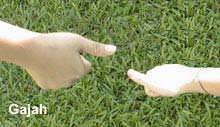In this age of electronic games and hi tech toys, we often forget that it is often the simplest of inventions that can entertain a child for a long period of time. Although state-of-the-art, high tech computer games are available in Indonesia, such as the ever-popular Nintendo and Playstation, these modern inventions are not affordable for the majority of the population.During the recent years of economic crisis, it is often hard for parents to make enough money to feed their family, so toys are often quite simple or something that has been made by the parent. Fortunately, traditional toys are not expensive ... and are fun! The toys and the games that are described below are commonly seen and played by Indonesian children today.
Kelereng or Gundu
Kelereng, or marbles to the western world, is a favorite with boys. There are many variations of games played with marbles.One of the more popular versions is that a small circle is drawn on the ground. All the players put one of their
 marbles within the circle. Then each of the players drops another marble to a point outside of the drawn circle. The player that owns the marble furthest away from the circle is entitled to play first.
marbles within the circle. Then each of the players drops another marble to a point outside of the drawn circle. The player that owns the marble furthest away from the circle is entitled to play first.He must attempt to use the marble that is outside of the circle (striker) to hit the marbles within the circle and knock them outside of the ring. If he is successful in doing, this he is entitled to keep the marbles that he has knocked out of the circle. The striker marble, however, must also come to rest outside of the drawn circle. If it does not, this marble must remain within the circle and the owner then forfeits this marble.
If the player is successful in knocking one of his opponents' marbles out of the ring, he can continue his turn and try to strike any other opponents. striker marbles. If he is successful in hitting his opponents. striker marble, he is entitled to take that marble and his opponent can no longer play the current round. If however he misses his opponents. striker marble, he looses his turn and the next player can then start to play.
Gangsing or Gasing
This game is normally played by boys. The gangsing is a top made from bamboo with a small opening on the side. This small hole makes the top whistle very distinctively as it spins. The size of the hole determines the pitch of the whistle. String is wound around the dowel that goes through the center of the gangsing . The child then holds onto the flat bamboo handle that is tied to the end of the string and pulls this handle to set the gangsing spinning. Normally a circle is drawn on the ground about 50 cm. in diameter. Two children play against each other. The object of the game is to try and knock your opponents gangsing out of the designated circle. Gangsing are commonly sold outside the temples and tourist attractions in Yogyakarta, Central Java.
spins. The size of the hole determines the pitch of the whistle. String is wound around the dowel that goes through the center of the gangsing . The child then holds onto the flat bamboo handle that is tied to the end of the string and pulls this handle to set the gangsing spinning. Normally a circle is drawn on the ground about 50 cm. in diameter. Two children play against each other. The object of the game is to try and knock your opponents gangsing out of the designated circle. Gangsing are commonly sold outside the temples and tourist attractions in Yogyakarta, Central Java.Lompat Tali
This is a very popular game which elementary school girls play at recess time. It is much like skipping rope however the rope that the girls use is made from hundreds of elastic bands that are looped together to form a large ring. The girls take turns trying to jump over the elastic rope which is held by two girls at each end.The height of the rope normally starts low, such as at ankle height, and gradually moves higher up the bodies of the children after the jumpers have successfully jumped over the lower height. Experienced jumpers can often jump over ropes that are neck high! A good thing that comes from using a rope that is made from rubber bands, is that if a jumper is not successful in jumping over the rope, the rope will give and the jumper will not be hurt in her unsuccessful attempt. Thus, a lot of skinned knees are avoided.
Bekel
This is the equivalent of western jacks, and is commonly played by Indonesian girls. The shape of the bekel differs from the western jacks in that they are flat with a small bridge holding the two sides together. On the upper side of the biji bekel there is a small red dot that is called the pit. The under side of the bekel is called a roh. On one of the flat sides of the biji bekel there are small indentations or dots and the other side is smooth. The game is played is a similar method to jacks, but with a few differences. When the game is started, the biji bekel are all held in the hand of the player and are dropped as the ball is allowed to bounce one time. The player then starts to play by attempting to pick up the biji bekel one at a time without disturbing any of the other biji bekel within the time that it takes the ball to bounce once.
The game is played is a similar method to jacks, but with a few differences. When the game is started, the biji bekel are all held in the hand of the player and are dropped as the ball is allowed to bounce one time. The player then starts to play by attempting to pick up the biji bekel one at a time without disturbing any of the other biji bekel within the time that it takes the ball to bounce once.If the player successfully has picked up all of the bekel, he then drops them again and starts the second set of the game. In this set he must attempt to position the biji bekel with the pit facing up again one at a time. This action must be completed while the player throws the ball in the air and allows it to bounce one time. The player must attempt to turn over the bekel without moving any of the other bekel.
If the player completes this successfully, he then picks up the biji bekel one at a time while throwing the ball in the air until he has all of the biji bekel in his hand. He then drops them all again and now picks the biji bekel up two at a time and then three at a time, etc. until he picks up all the biji bekel with one sweep of the hand.
He drops them again and now starts the roh set. The player must attempt to turn over all the biji bekel so the roh side is now facing up. It is permitted to pick up more than one group of the set number while the ball is being thrown in the air. For example if the player is picking up groups of two while the ball is being thrown in the air, he may grab three groups of two bekel. The action of grabbing a set number of bekel is called cek.
If the player moves any of the biji bekel that he is not attempting to pick up, or if he drops any of the biji bekel in his hand, he loses his turn and it goes to the next player. A skilled player can go through many sets of the game before he makes a mistake and has to turn the bekel over to the next player. The player that completes the most sets without making a mistake is considered the winner of the game.
The name is derived from the Dutch game"bikkelen" using the same copper "bikkels".
Kuda Lumping
These small replicas of the larger kuda lumping that are used in a trance dance on Java are cut out from woven bamboo mats and painted with striking colored patterns. Sequins, beads and other materials can also be added to give the kuda lumping its colorful appearance.
bamboo mats and painted with striking colored patterns. Sequins, beads and other materials can also be added to give the kuda lumping its colorful appearance.When given to a child, their imaginative minds are the only limit as to what dramas these kuda lumping are the center of! Although intended as a toy, many of these delightful horses end up in suitcases to be given as souvenirs of an expat's trip to Indonesia or smaller more colorful versions can be used as eye-catching decorations on Christmas trees.
Semut, Orang, Gajah
This game is popular throughout Asia, just as it is throughout the world in all its variations. I remember playing a paper, scissors, stone game of similar design. In Indonesia the game is also known as suwitan or pingsut and is played by young children to see who goes first in play, or just for fun to see who wins.Hand signs:
| semut - antLittle finger points towards partner |  |
| orang - personPointer finger points towards partner |  |
| gajah - elephantThumb points towards partner |  |
Face your partner with your hand in front of you in a fist. Then, count to three together, open you hand and make one of the three hand signs. If both of you make the same sign, start again.
The Winner:
The semut wins over the gajah because the semut can crawl in the gajah. s ear and tickle him to drive him crazy.
The orang wins over the semut because the orang can stomp on the semut and squash it.
The gajah wins over the orang because the orang can get trampled by the gajah.
Congklak or Dakon
One of the oldest known games in the world, congklak can be traced as far back as ancient Egypt. Brought to Indonesia, probably centuries ago by Arab or Indian traders, it is just as popular in Indonesia today as it has been for through the ages.Congklak is played on a board with circular indentations along both sides and a home indentation on each end of the board.
Indonesia, probably centuries ago by Arab or Indian traders, it is just as popular in Indonesia today as it has been for through the ages.Congklak is played on a board with circular indentations along both sides and a home indentation on each end of the board.The game is played with 98 small markers such as shells or beads, which are divided evenly between all the indentations. Although at first glance this many appear to be some type of calculator, it is quite a challenging strategic game and takes a lot of practice before a player becomes skilled.
HUUU.. I miss those games for sure!
Resource: www.expat.or.id

0 comments:
Post a Comment